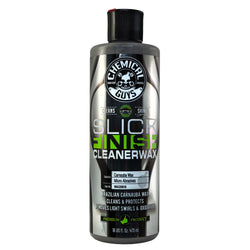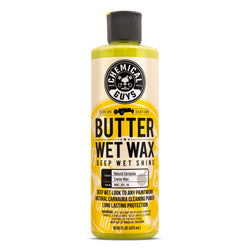| Exterior How-To's | |
| Interior How-To's | |
| Drying How-To's | |
| Latest Innovations | |
| Ceramic How-To's | |
| Detailing University |
Detailing your car is a rewarding experience, and let’s be honest, who doesn’t love a car that looks like it just rolled off the showroom floor? But it’s not just about the shine—it’s about protecting your paint, extending the life of your ride, and keeping that value intact. If you're new to the detailing world, this guide will help you dodge the most common mistakes and ensure your car looks its absolute best.
Making the wrong moves when detailing can lead to scratches, paint damage, and some seriously annoying imperfections. But fear not! By avoiding these rookie errors, you’ll not only get that professional finish but save time, money, and effort in the process.
Let’s dive into the top five car detailing mistakes and how to avoid them. Your ride (and your wallet) will thank you!
Prepare Your Gear
Before you dive into the detailing fun, it’s essential to have the right tools on hand. Here’s the lineup of must-have products we’ll be talking about to make your detailing session a breeze:
- Slick Finish Cleaner Wax
A wax that goes the extra mile—this one’s packed with abrasives to remove light scratches while giving your car a dazzling shine.
- Butter Wet Wax
The gentler, no-scratch solution. Perfect for removing scuff marks, paint transfers, and overspray without damaging your paint. It’s all about that smooth, glossy finish.
- Workhorse Professional Grade Microfiber Towel 3-Pack
Color-coded towels that keep your cleaning process tidy and prevent cross-contamination. You’ll always know which towel is for which task!
- Woolly Mammoth Microfiber Drying TowelYour car’s new best friend. This towel is super absorbent, so you can dry your car without worrying about leaving behind pesky water spots.
- Clay Luber
This specially designed lubricant ensures your clay bar glides over the surface smoothly, preventing scratches or marring. It's like butter for your clay bar.
Mistake 1: Assuming All Waxes Remove Paint Scratches

One of the biggest myths in car detailing? Thinking that all waxes can magically erase scratches. Spoiler alert: It’s not that simple!
Take Chemical Guys Slick Finish Cleaner Wax, for example. This wax packs mild abrasives that can handle light scratches and imperfections on your paint. But if you're hoping to fix deep scratches, this isn’t the wax you’re looking for.
Now, Butter Wet Wax is a different beast altogether. No abrasives here—just natural cleaning oils. This wax is perfect for removing scuff marks, paint transfers, overspray, and other surface blemishes, but don’t expect it to touch those pesky scratches.
The moral of the story: Know your wax and its ingredients. It’s the key to making sure you get the results you're after!
Want to dive deeper? Check out our How to Wax Your Car: A Step-by-Step Guide!
Mistake 2: Using a Clay Bar to Remove Scratches

Let’s clear up a big misconception: Clay bars do NOT remove scratches. They’re not designed for that. Clay bars are all about decontamination. They remove embedded contaminants like tree sap, industrial fallout, and road tar to leave your paint feeling as smooth as glass.
If your paint feels rough or gritty, it's time for a clay bar treatment. But don’t expect it to fix those deep scratches.
Another popular question: Can clay bars remove oxidation? The short answer: Not really. A clay bar can handle light oxidation, but if your car’s paint is really suffering, you’ll need a polishing treatment for better results.
Check out some of our clay bar options to suit your needs:
- OG Clay Bar (Light/Medium Duty, Yellow): Perfect for light to medium contamination. It’ll make your paint feel smooth and clean.
- Medium Duty Clay Bar: If the light-duty option isn’t cutting it, the medium-duty will really help restore that glass-like finish.
- Heavy Duty Clay Bar: For when your car’s been through the ringer. It extracts dirt, grime, and debris, giving you a thorough clean and restoring the paint’s smoothness.
Ready to get your paint feeling sleek? Learn how to use a clay bar with our How to Properly Clay Your Carguide!
Mistake 3: Cross-Contaminating Towels

A common but huge mistake many car owners make is using just one towel for their entire car.
Think about it: using the same towel on your tires and your paint? Not a good idea. Tires are dirty, grimy, and covered in contaminants. When you wipe down your paint with that same towel, you're introducing all that junk to the surface, which can scratch, mar, and leave imperfections.
The solution is simple: color-code your towels. Here’s a quick guide:
- Green towels: For exterior surfaces.
- Yellow towels: For interior cleaning.
- Blue towels: For windows and mirrors.
This method not only protects your car’s paint but makes the cleaning process much more efficient. And don’t forget to wash your towels separately to avoid cross-contamination!
Ready to upgrade your cleaning routine? Check out our entire Microfiber Towel Collection to find the right ones for the job.
Mistake 4: Skipping the Drying Step After a Coin Wash

Coin-operated car washes offer a budget-friendly alternative to professional detailing or automated services, as you only pay for the time and products you use. They’re also a more eco-friendly option for those looking to save water and energy.
However, there’s a catch: most coin-op washes don’t use deionized water, which means that if you don't dry your car after the wash, water spots can form. Dust and debris will stick to the paint, leaving unsightly marks that are tough to remove.
To avoid this, we recommend using a blower like our ProBlow Handheld Dryer & Blower or a Woolly Mammoth Microfiber Drying Towel. These tools will help you dry your car thoroughly, keeping it spot-free and looking fresh.
Learn More: How to Properly Dry Your Car After Washing
Mistake 5: Using Water as a Clay Bar Lubricant

Using plain water as a lubricant for clay bars is a common mistake, especially for beginners. While it might seem convenient, water tends to drag and can cause the clay bar to catch on the surface. This friction can lead to marring, scratching, and other paint damage.
To avoid this, Chemical Guys recommends using a dedicated clay lubricant, like our Clay Luber. This specially formulated lubricant allows the clay bar to glide effortlessly across the surface, reducing friction and minimizing the risk of damaging your paint. Plus, it ensures more effective contaminant removal.
Investing in the right lubricant will make the clay-barring process smoother, safer, and more efficient — delivering better results every time!
Learn More: How to Properly Clay Bar Your Car
By avoiding these 5 common mistakes, you’ll enjoy a flawless detailing experience and keep your car looking pristine. Whether you’re a beginner or a seasoned detailer, the right techniques and tools can make all the difference!
Frequent Questions About Common Detailing Mistakes
How do I know which wax is best for my car?
Identify your needs... use abrasive wax for light scratches and cleaning wax for scuffs and shine.
Why use different color towels for detailing different parts of my car?
Each area of your car (wheels, paint, glass, etc.) has unique contaminants that can harm other surfaces, so use different color towels to prevent cross contamination and avoid damage.
What do Clay Bars do to my car?
Clay bars lift embedded contaminants from the paint’s surface, restoring smoothness without abrasives.
Why does a Clay Bar need lubrication?
Lubrication reduces friction, allowing the clay bar to glide smoothly to prevent scratches.








